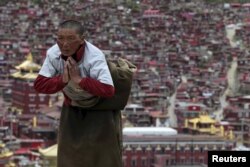Chinese authorities are placing tighter administrative controls over Larung Gar, a Buddhist study center, according to a report released by Human Rights Watch (HRW).
About 200 Communist Party cadres and lay officials "are taking over all management, finances, security, admissions, and even the choice of textbooks at the center, following demolitions and expulsions in 2017," according to the HRW report, which outlines the "micromanagement" of the monks, nuns and visitors to the institute founded in 1980.
"We think the latest developments at Larung Gar really are unprecedented," Sophie Richardson, the HRW China director, told VOA's Tibetan service, adding the controls are an "intrusion into the management security and even the textbooks of the community."
VOA emailed a request for comment on the HRW report to the Chinese Embassy in Washington but received no reply.
Larung Gar was founded by Khenpo Jigme Phuntsok, a highly regarded Tibetan Buddhist master. At one point, it was home to at least 10,000 monks, nuns, lay students and elderly people, although some tourism websites estimated there were closer to 40,000 people. The center has long been targeted by Beijing, which planned to reduce the Larung Gar population to 5,000 by September 2017.
Titled China: New Controls on Tibetan Monastery: Religious, Education Authority Shifts to Party Cadres, the HRW report is based on an undated brochure printed in Chinese and Tibetan.
The brochure, A Simplified Program for the Separation of the Institute and Monastery at Larung Monastery Five Sciences Buddhist Institute, was apparently issued by local Chinese Communist Party authorities, according to HRW.
Authorities will split Larung Gar into two sections — an academy and a monastery — divided by a wall, according to an English-language translation of the document provided by HRW. The human rights group said it had received it in August 2017.
The academy will have no more than 1,500 residents, most of them monks, according to the HRW report, and the monastery with have a maximum of 3,500 nuns.
The monks and nuns at Larung Gar will be subject to "increased security and heightened control," including restrictions on how many of them will be allowed to stay there, according to the HRW report. Ongoing surveillance will be tightened with the use of a "grid management" system, the report says, and visitors, as well as the nuns and monks, will be required to have identifying tags — red for monks, yellow for nuns and green for lay people.
"The new government controls over Larung Gar fly in the face of party claims that China respects constitutionally protected religious beliefs," Richardson said in an HRW release.
Since 2008, the number of monks across the Tibetan Autonomous Region (TAR) has fallen, leaving most monasteries with only a handful of monks, who are overseen by Chinese Communist Party members in charge of the facilities.
Many monks in the region decamped to Larung Gar in order to continue their studies.
In 2014, however, TAR-based Chinese officials ordered families in Driru County to bring monks back from Larung Gar and other monasteries in Ganze prefecture.
In August 2017, six members of the ruling Chinese Communist Party, all of them Tibetan, were appointed to manage the day-to-day affairs of Larung Gar, according to Radio Free Asia, which also reported on the establishment of checkpoints on the main road leading to the complex.
Relations between China and Tibetans have been uneasy since the Chinese army marched into Tibetan territory in 1950, land China contends had been in its orbit since the 13th century.
Many Tibetans believe Beijing is trying to suppress Tibet's language, freedom of expression and religion while allowing migration of Chinese citizens and the construction of major infrastructure projects in the region. Chinese authorities say their presence has raised the local living standards while allowing the Tibetans much autonomy.
This report originated with VOA's Tibetan service.









